
WHAT ARE BRASSICAS, EXACTLY?
01/15/21 — Ada Broussard
As farm people, the word “Brassicas” is a regular player in our working dictionary of botany terms and tractor parts. Brassicas this, and Brassicas that. It’s a fun word to say and is particularly useful because it describes a large group of crops we grow. Seeing as you’re reading a farm blog right now, chances are you’re a lover of seasonal vegetables and a locavore, too. Does “Brassica” roll off your tongue with the confidence of a vegetable farmer? We think it should. Read on and you’ll realize that you already know these cruciferous vegetables. If you’re eating from a CSA box or JBG market haul, big and baby Brassicas alike have no doubt been on your plate more often this winter than not.
![]() Brenton with a few Brassicas.
Brenton with a few Brassicas.
Brassica is a genus of plants in the mustard family, or Brassicaceae in Latin, whose members are informally referred to as cruciferous vegetables, not to be confused with a crucifer, which has something to do with carrying a cross. The Brassica family contains many species and subspecies, several of which are responsible for growing some of the world’s most important agricultural crops. Brassicas love the cool weather, making them a late fall, winter, and early spring crop here in Central Texas. We push the seasonal windows with some of our Brassicas, but really - their time to shine is right this very instant.
So what the heck actually are Brassicas? The list of cruciferous vegetables we grow is long: kohlrabi, brussels sprouts, cabbages (all of them), broccoli, cauliflower, romanesco, turnips, bok choy, kale, collards, mustard greens, radishes, rutabaga, arugula, and all the diverse and specialty versions of those things you see on our spray tables. Did we forget one? Maybe… Brassicas rule over our winter crop plan with a partisan authority. Each one of these distinct but closely related vegetables was bred over the course of around 10,000 years by enterprising farmers all over the world making Brassicas one of the oldest cultivated crops we know of.
![]()
![]() We went to Brenton's Instagram (@farmerbrenton) because we know there was one photo of him with "the biggest brussel sprout" he's ever seen. We quickly realized that Brenton's Instagram is truly just a series of photos of Brenton with Brassicas over the years. He poses with no other plant family, it seems.
We went to Brenton's Instagram (@farmerbrenton) because we know there was one photo of him with "the biggest brussel sprout" he's ever seen. We quickly realized that Brenton's Instagram is truly just a series of photos of Brenton with Brassicas over the years. He poses with no other plant family, it seems.
Perhaps the most fascinating species of Brassica is Brassica oleracea which has undergone several rounds of domestication selection, all stemming (get it) from the same wild progenitor. If you’re interested in a botanical deep dive of this species, check out this blog post titled “The extraordinary diversity of Brassica oleracea” by Jeanne L. D. Osnas, a Ph.D. plant ecologist and evolutionary biologist. Who loves to cook. (Really, it’s an incredible blog.) Jeanne writes, “Some species have undergone the domestication process multiple times, and with some of these species, each domestication effort has focused on amplifying different structures of the plant...Such is the case with Brassica oleracea. The wild plant is a weedy little herb that prefers to grow on limestone outcroppings all around the coastal Mediterranean region. It is a biennial plant that uses food reserves stored over the winter in its rosette of leaves to produce a spike of a few yellow flowers at the end of its second summer before dying”.
Get ready to have your mind blown. Brassica oleracea makes up 9 of the vegetables we grow at JBG including red and green cabbage, broccoli, cauliflower, romanesco, Brussels sprouts (none this season, sorry), collards, kales, Savoy cabbage, and kohlrabi. Have you ever marveled at how Brussels sprouts just look like tiny cabbages? Or noticed that kohlrabi leaves taste a hell of a lot like collards? Deep down, you know that broccoli and cauliflower are deeply connected, but why does it all feel so familiar? It’s because it’s all the same plant! Check out the nifty chart below for a refresher on exactly what part of Brassica oleracea was selected to yield some of your favorite winter veggies.
![]() Graphic from Business Insider. One plant, many vegetables.
Graphic from Business Insider. One plant, many vegetables.
![]() Apparently, there is a meme for everything.
Apparently, there is a meme for everything.
![]()
We’re literally brimming in Brassicas right now, and each and everyone has an interesting evolution from a wild mustard weed blowing in the wind to a starchy root crop (turnip) or spicy leaf (arugula) or a bouquet of buds (broccoli). Enjoy your little Brassicals before it’s hot outside and they’ve flown the coop. Thanks for reading!
![]() Brassicas on Brassicas on Brassicas.
Brassicas on Brassicas on Brassicas.
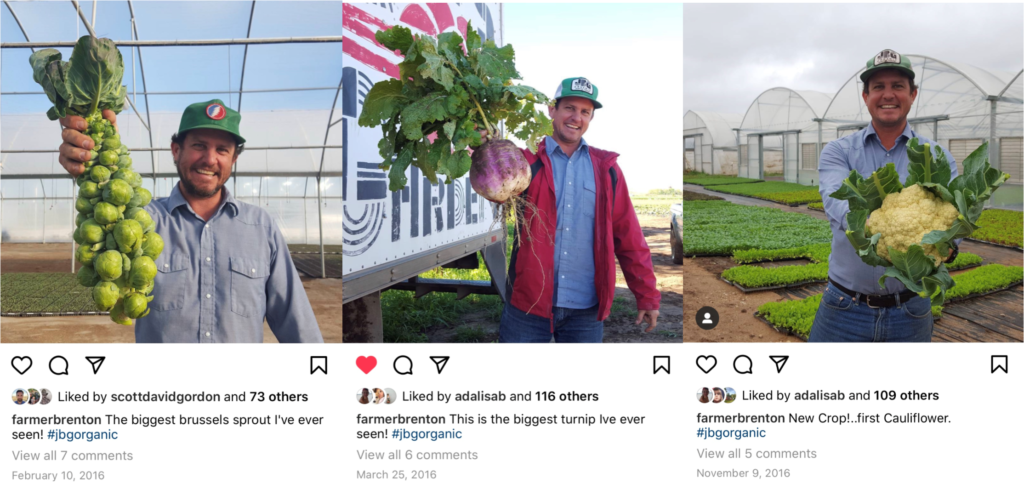 Brenton with a few Brassicas.
Brenton with a few Brassicas.
Brassica is a genus of plants in the mustard family, or Brassicaceae in Latin, whose members are informally referred to as cruciferous vegetables, not to be confused with a crucifer, which has something to do with carrying a cross. The Brassica family contains many species and subspecies, several of which are responsible for growing some of the world’s most important agricultural crops. Brassicas love the cool weather, making them a late fall, winter, and early spring crop here in Central Texas. We push the seasonal windows with some of our Brassicas, but really - their time to shine is right this very instant.
So what the heck actually are Brassicas? The list of cruciferous vegetables we grow is long: kohlrabi, brussels sprouts, cabbages (all of them), broccoli, cauliflower, romanesco, turnips, bok choy, kale, collards, mustard greens, radishes, rutabaga, arugula, and all the diverse and specialty versions of those things you see on our spray tables. Did we forget one? Maybe… Brassicas rule over our winter crop plan with a partisan authority. Each one of these distinct but closely related vegetables was bred over the course of around 10,000 years by enterprising farmers all over the world making Brassicas one of the oldest cultivated crops we know of.
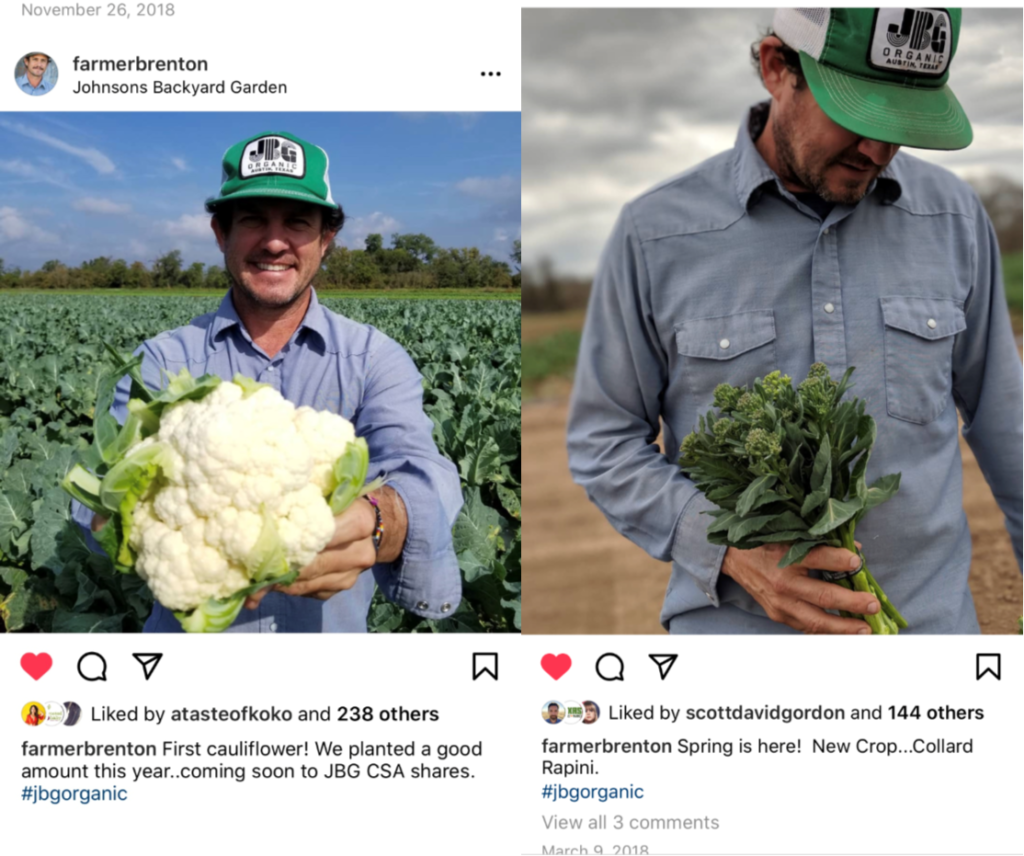
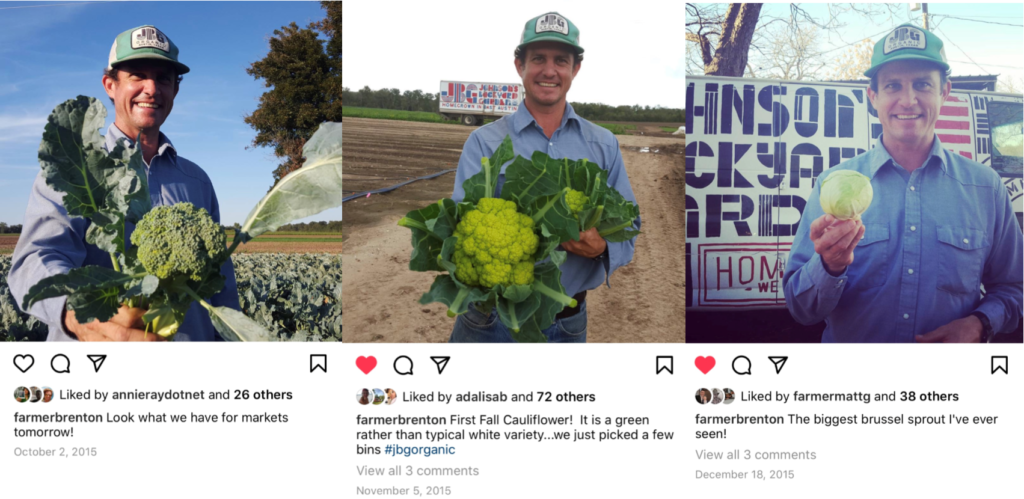 We went to Brenton's Instagram (@farmerbrenton) because we know there was one photo of him with "the biggest brussel sprout" he's ever seen. We quickly realized that Brenton's Instagram is truly just a series of photos of Brenton with Brassicas over the years. He poses with no other plant family, it seems.
We went to Brenton's Instagram (@farmerbrenton) because we know there was one photo of him with "the biggest brussel sprout" he's ever seen. We quickly realized that Brenton's Instagram is truly just a series of photos of Brenton with Brassicas over the years. He poses with no other plant family, it seems.
Perhaps the most fascinating species of Brassica is Brassica oleracea which has undergone several rounds of domestication selection, all stemming (get it) from the same wild progenitor. If you’re interested in a botanical deep dive of this species, check out this blog post titled “The extraordinary diversity of Brassica oleracea” by Jeanne L. D. Osnas, a Ph.D. plant ecologist and evolutionary biologist. Who loves to cook. (Really, it’s an incredible blog.) Jeanne writes, “Some species have undergone the domestication process multiple times, and with some of these species, each domestication effort has focused on amplifying different structures of the plant...Such is the case with Brassica oleracea. The wild plant is a weedy little herb that prefers to grow on limestone outcroppings all around the coastal Mediterranean region. It is a biennial plant that uses food reserves stored over the winter in its rosette of leaves to produce a spike of a few yellow flowers at the end of its second summer before dying”.
Get ready to have your mind blown. Brassica oleracea makes up 9 of the vegetables we grow at JBG including red and green cabbage, broccoli, cauliflower, romanesco, Brussels sprouts (none this season, sorry), collards, kales, Savoy cabbage, and kohlrabi. Have you ever marveled at how Brussels sprouts just look like tiny cabbages? Or noticed that kohlrabi leaves taste a hell of a lot like collards? Deep down, you know that broccoli and cauliflower are deeply connected, but why does it all feel so familiar? It’s because it’s all the same plant! Check out the nifty chart below for a refresher on exactly what part of Brassica oleracea was selected to yield some of your favorite winter veggies.
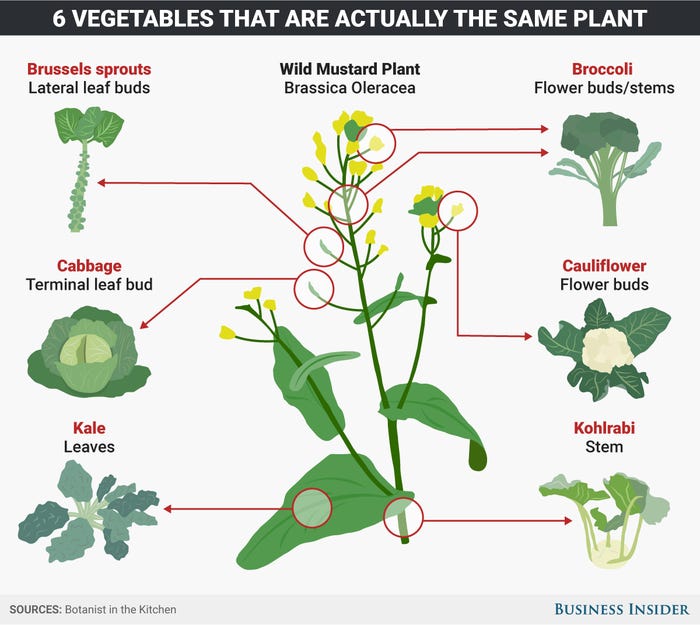 Graphic from Business Insider. One plant, many vegetables.
Graphic from Business Insider. One plant, many vegetables.
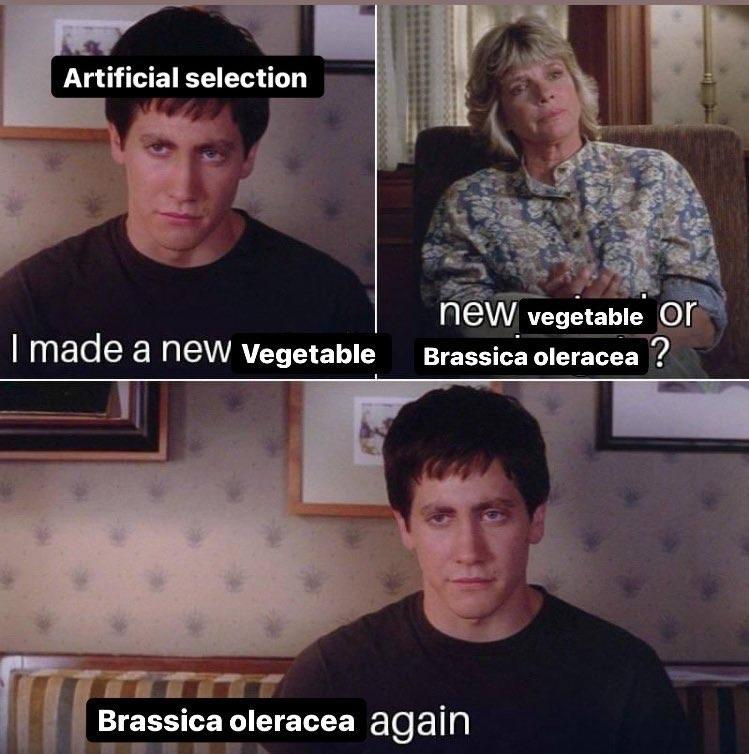 Apparently, there is a meme for everything.
Apparently, there is a meme for everything.

We’re literally brimming in Brassicas right now, and each and everyone has an interesting evolution from a wild mustard weed blowing in the wind to a starchy root crop (turnip) or spicy leaf (arugula) or a bouquet of buds (broccoli). Enjoy your little Brassicals before it’s hot outside and they’ve flown the coop. Thanks for reading!
 Brassicas on Brassicas on Brassicas.
Brassicas on Brassicas on Brassicas.





 0 ITEMS IN CART
0 ITEMS IN CART 

